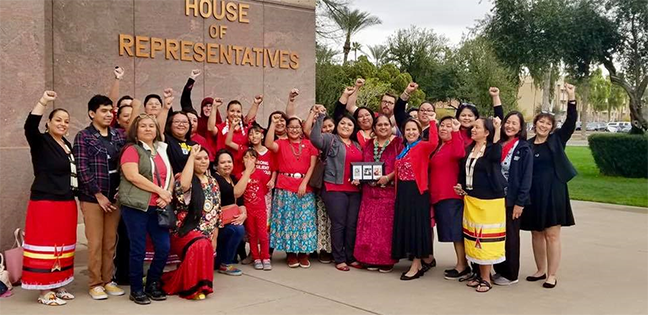Last Wednesday, the Arizona House of Representatives unanimously passed House Bill 2570, which intends to create the first study committee on violence against Indigenous women and girls in the state.
If passed by the Senate and approved by the governor, a committee of statewide experts and stakeholders will conduct a comprehensive study to identify causes of systemic violence against Indigenous women and girls and establish methods for tracking and collecting data.
The issue has recently picked up attention in the mainstream media, but has been a reality in tribal communities for generations.
April Ignacio, a member of the Tohono O'odham Nation, conducted her own research on the subject after witnessing the lack of streamlined data on cases in her own community. In more than 30 interviews with families of missing and murdered Indigenous women and girls, including LGBTQ women in just the Phoenix and Tucson areas, Ignacio has compiled information on cases dating back to the 1970s. The oldest victim was 54 and the youngest was just four months old.
"I was trying to make sure that the women in my community were honored in a way that will help with these grieving families who felt like they are not going to get justice because their loved one is no longer with us on this Earth," Ignacio said. "I think first and foremost that was how the research began was kind of making a platform for them to be able to tell their story, tell their truth."
She sees the problem as multilayered, but a major cause is the lack of collaboration and communication between tribal, municipal and state law enforcement agencies. When Indigenous women go missing or are murdered in urban jurisdictions, officers, including those in the Tucson Police Department, do not track their tribal affiliations and may misclassify their ethnicity.
"There needs to be some sort of accountability when it comes to police departments and the classification of Indigenous people, our Native people, in the cities because what we know is that 70 percent of Native Americans live in urban areas and in cities," Ignacio said. "Us as a community, we're at a loss because of the crimes that were committed against these women but there was no follow through, there was no follow-up and so some of these cases are cold or they went unsolved."
Valaura Imus-Nahsonhoya works with the National Criminal Justice Training Center and as a private consultant to provide training and assistance related to victim services in the judicial system. For 16 years she has provided direct assistance to crime victims and their families with a particular focus on sex-trafficking cases.
"The challenge I face is the cooperative relationship with law enforcement to develop a coordinated effort in addressing our missing and murdered Indigenous women and girls and violence against Native American women," Imus-Nahsonhoya said during a Health and Human Services Committee hearing in February. "The challenge of developing a coordinated effort in providing a culturally appropriate response to advocating for families in a non-cultural environment such as our communities here in Phoenix."
One of the only national research studies on this issue is from the Urban Indian Health Institute based in Seattle, and it has been making headlines since its release in November 2018. One of the most revealing findings was that in 2016, there were 5,712 reports of missing American Indian and Alaska Native women and girls, though the U.S. Department of Justice's federal missing persons database, NamUs, only logged 116 cases. Arizona was ranked the third most dangerous state for Indigenous women with 54 cases, and Tucson was the fourth most dangerous city in the country with 30 recorded murders.
The Center for Disease Control and Prevention has reported that murder is the third-leading cause of death among American Indian and Alaska Native women, and that rates of violence against these women can be up to ten times higher than the national average.
Ignacio said that Native women are 85 percent more likely to be sexually assaulted in their lifetimes. In her research alone, 90 percent of the cases she studied involved domestic violence.
The study from UIHI offers a valuable look at the problem nationwide, but the authors acknowledge their numbers are likely an undercount and do not accurately depict the severity of the issue. Ignacio and other experts also believe the official numbers of missing and murdered Indigenous women and girls are lacking. No study can obtain accurate numbers without the cooperation of various law enforcement agencies on the local, tribal, state and federal levels.
"Because there isn't a comprehensive study all across the board that actually works in connection with law enforcement, those numbers will always straddle," Ignacio told members of the Health and Human Services Committee. "The UIHI study was a volunteer-based study with different municipalities in the United States, so those cities volunteered that information."
H.B. 2570 could be that comprehensive study. Rep. Jennifer Jermaine (LD-18) who introduced the bill in the House told other legislators at the Health and Human Services Committee hearing that the information is virtually unavailable. Law enforcement agencies either don't track tribal affiliations in their reports or did not respond to related FOIA requests.
"As a state legislator, I have also reached out to these cities to try to obtain that information to no avail," Jermaine told the committee. "The lack of data on this topic is appalling. We need the weight of a state-authorized study to get multiple urban, rural and sovereign tribal law enforcement agencies as well as community partners like health care, social work and domestic violence prevention agencies working together to solve this problem."
The bill has a total of 42 sponsors, six Republicans and 36 Democrats. It received unanimous support from the Health and Human Services Committee.
The study, if approved, will include seven Arizona tribes. The study committee will comprise all members of the Indigenous Peoples Caucus, the Arizona attorney general or their designee, the director of the Department of Public Safety or their designee, attorneys and sheriffs from urban and rural counties, representatives from tribal government and law enforcement, victims advocates, social workers, counselors, and legal and health service experts.
Once the study is complete, the findings will be presented to tribal leadership and the state legislature so these institutions can begin to form a whole picture of the crisis over missing and murdered Indigenous women and girls in the State of Arizona, Jermaine said at the hearing. With concrete data, more policies could be enacted to prevent more women from going missing or being killed.
"We've never tried in this topic to bring everyone into one room to try to look at the data and try to solve the issue," she said. "That is what the goal of this committee is to bring everybody together to specifically address that."
Debbie Nez-Manuel, a member of the Salt River Indian community, is the daughter of a murdered Indigenous woman who was killed when she was just two years old. She gave testimony in support of H.B. 2570 during the committee hearing.
"For the past four decades, I have persevered through countless barriers," Nez-Manuel said to legislators. "I've gathered strength from deep within and I've found reasons to survive without my parent. Today I am in favor of advocating for this study, knowing the long-term implications as it directly related to practices that are proactive for children in the modern day."
She said effective practices between tribal and state agencies are long overdue in a state like Arizona, where over 22 federal tribes are represented.
"Today my voice is on behalf of the children because of my path, because of my experiences," Nez-Manuel said. "We have countless advocates who have been working on this for years, but we know that through data, research and information we can do a lot more."
Ignacio said the Navajo Nation, which is the largest reservation in the United States with boundaries stretching across Arizona, New Mexico and Utah, has started to gather its resources and begin the necessary steps to collect its own data. This kind of data collection would be groundbreaking within the Tohono O'odham Nation.
She and other advocates for the bill are confident that it will receive similar support when it goes to the Senate Floor for a vote.











